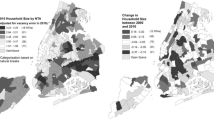The San Diego Association of Governments (SANDAG) has produced small area population estimates for San Diego County since 1984. SANDAG uses the housing unit method of population estimation and controls small area estimates (i.e. census tract level or smaller) to January 1 city and county population totals published by the California Department of Finance (DOF) in May each year. Because the small area estimates are based on housing unit counts, it is important to get the most accurate and timely data available.
Originally SANDAG produced estimates at the census tract level. Later a splittract geography was introduced so that estimates could be produced for cities, zip codes, school districts, and other political and administrative areas by aggregating estimates for the split tracts. The next progression was to split blocks to allow the compilation of estimates for more customized areas within the county. From split blocks, the natural evolution was to producing estimates at an even smaller geography: the parcel. Parcels are individual house- or business-lots that are tracked by a tax assessor for ownership and taxation purposes. Currently SANDAG produces housing unit and group quarters population estimates at the parcel level. Plans are to develop household population and characteristics estimates at the parcel level using microsimulation techniques.
Access this chapter
Tax calculation will be finalised at checkout
Purchases are for personal use only
Preview
Unable to display preview. Download preview PDF.
Similar content being viewed by others
References
Bowman, J.L. and G. Rousseau (2006). Validation of the Atlanta (ARC) Population Synthesizer (PopSyn). Paper prepared for the TRB Conference on Innovations in Travel Modeling, Austin, Texas.
Byerly, E. (1990). State and Local Agencies Preparing Population and Housing Estimates. Current Population Report, U.S. Department of Commerce, Bureau of the Census.
Hunt, J.D. and J.E. Abraham (2003). Design and Application of the PECAS Land Use Modeling System. Paper presented at the 8th Computers in Urban Planning and Urban Management Conference, Sendai, Japan.
Image Link. (2000). 2-foot True Color Imagery. San Diego (West).
Longley, P. (2000). Spatial Analysis in the New Millennium. Annals of the Association of American Geographers 90(1): 157-165.
Rynerson, C. and J. Tayman (1998). An Evaluation of Address-Level Administrative Records Used to Prepare Small Area Population Estimates. Paper presented at the meeting of the Population Association of America, Chicago, Illinois.
San Diego Association of Governments - SANDAG (2006). Current Estimates. San Diego, California.
San Diego Geographic Information Source - SanGIS. (2000). Parcel File.
Smith, S.K. and M. Mandell (1984). A Comparison of Population Estimation Methods: Housing Unit Versus Component II, Ratio Correlation, and Administrative Records. Journal of the American Statistical Association 79(386): 282-289.
Starsinic, D.E. and M. Zitter (1968). Accuracy of the Housing Unit Method in Preparing Population Estimates for Cities. Demography 5(1): 475-484.
State of California, Department of Finance (2006). E-5 Population and Housing Estimates for Cities, Counties and the State, 2001-2006, with 2000 Benchmark. Sacramento, California, May 2006.
Swanson, D. and L.G. Pol (2005). Applied Demography in the United States and Implications for Practice Elsewhere. Paper presented at the International Population Conference, International Union for the Scientific Study of Population, Tours, France.
U.S. Department of Commerce, Bureau of the Census. Census 2000, Summary File 1 (SF 1) and Summary File 3 (SF 3).
Author information
Authors and Affiliations
Editor information
Editors and Affiliations
Rights and permissions
Copyright information
© 2008 Springer Science + Business Media B.V
About this chapter
Cite this chapter
Jarosz, B. (2008). Using Assessor Parcel Data to Maintain Housing Unit Counts for Small Area Population Estimates. In: Murdock, S.H., Swanson, D.A. (eds) Applied Demography in the 21st Century. Springer, Dordrecht. https://doi.org/10.1007/978-1-4020-8329-7_5
Download citation
DOI: https://doi.org/10.1007/978-1-4020-8329-7_5
Publisher Name: Springer, Dordrecht
Print ISBN: 978-1-4020-8328-0
Online ISBN: 978-1-4020-8329-7
eBook Packages: Humanities, Social Sciences and LawSocial Sciences (R0)



